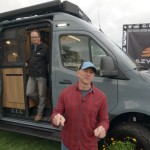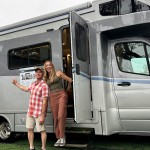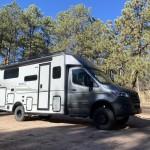This post may contain affiliate links.
With the release of Winnebago’s second EKKO floor plan on the Sprinter chassis, it’s natural to think about the differences between the two and to wonder which one might work better for you. Since we’ve owned a Transit EKKO (or, TrEKKO) for years, and since we recently spent a day reviewing the Sprinter EKKO (or SprEKKO), we thought we’d share our perspective on the differences between the two. Check it out!
A couple prerequisites may be helpful as you watch this.
First – this video assumes you’ve seen our EKKO Sprinter complete review. If you haven’t yet, watch that one.
And if you’re not familiar with the original EKKO Transit, our detailed review of that is here.
Our video focuses on the 6 areas where we found the greatest differences between the two rigs.
- The gear garage
- The exterior size
- The driving characteristics
- The bedroom
- The front lounge area
- The electrical systems
There’s not a winner or a loser here. The two coaches are simply different in these areas. And which one might work better for you is something you need to figure out, based on how you RV. Hopefully, this video helps with that.
If you’ve got any questions or comments, sound off in the comments below and we’ll try our best to get them answered.
Cheers!











Really informative videos. Thanks, as always. One thing I didn’t notice your comments on was road noise, particularly at highway speeds, for the the Sprekko? Others have commented on the Transit-based Ekko being rather noisy, so I’m wondering if the MB version is improved. Thanks.
I’ve done a lot of work to make our own Transit EKKO rather quiet while we drive. So a comparison to our own EKKO wouldn’t be fair. And we didn’t have a stock Transit EKKO nearby to do a proper A/B comparison.
Anecdotally, it seemed louder than our own EKKO, but well in line with what we’ve experienced with other RVs.
Terrific review — and entertaining as usual. Thank you.
How does the cargo carrying capacity (CCC) compare between the Transit and Sprinter versions of the EKKO?
Ya know… that’s the one thing we forgot to get footage of.
But, the GVWR for both the Transit and the Sprinter are very close. The Sprinter wins by just 30 lbs.
I’d expect it to be pretty much a wash.
The GVWR is similar, but the Trekko is smaller, so lighter itself, leaving more cargo capacity, no?
We have a deposit down on a Sprekko and I added up the heavier things like us and water, and a second battery (we’re adding one) and there is only about 100 pounds left over for everything else. I’m wondering how you do it with all those batteries? I know you save 60lbs right off the bat with our propane, but still.
Here are my rough estimates. We’ll be out in CA winters.
1208 CCC
My wife and I = 350 lbs
extra lithionics battery 68 lbs
Water full 433 lbs (obviously doesn’t have to be full except when heading off to bookdock for a while)
Cassette full 8.3×5 = 41 lbs
2 E-Bikes estimate is 150
2 gallons of antifreeze 16.5 (maybe not needed with ekko)
Drinking water 25 for 3 gal (probably will want more)
xtra propane 20lbs (kind of important in winter)
105 balance for clothes, food, tools, starlink, weboost, extra cassette, connectors, hoses, bedding, cleaning supplies, levelers, etc
I don’t have any data on the weights of the bare chassis, so I don’t know what to tell you on that score.
But as far as your weight estimates… there are a number of ways that our personal RVing differs from what you’ve listed, but to pick a few
We don’t travel with full water unless we know we’ll need it. Saves on gas, too!
Our bikes are about a hundred pounds lighter than your estimate.
Antifreeze not necessary. We don’t travel with it, and use it only in storage. You can buy it most anywhere if you think you need it.
We treat and drink the water from our RV’s tank. So we don’t need the expense, space, and weight for yet more water.
Extra propane not necessary. I don’t know of a single EKKO owner who travels with a third tank. You’ll move before burning up two whole tanks.
That said, extra weight capacity is always a good thing.
Thought an update of our deliberations on the CCC difference between the two might be helpful to someone. We are deciding between a Sprekko with 1200 lbs CCC and a Trekko with 1600. Absolute CCC is based on options, of course.
The four hundred+ pound difference matters. My wife and I are 350 (we’re not as fit as you two 😉 ) plus a full tank of water is 433 lbs. We want two batteries (+63 lbs) which leaves only 354 lbs for every other thing we want to take on the Sprekko, including e-bikes (we’re not as fit as you two), groceries, kitchenware, clothes, tools, work, low equipment hobbies, and RV needs. I estimate we’ll be 200+ lbs over.
Yes, we can only fill the water halfway or less, which is what we’ll typically do, until we need it. Or we can run overweight, which after MUCH reading, may or may not be a problem. And when we take our son, we’ll have no room for water.
After a few days of study, we switched our deposit to the gen-delete Trekko. We can get by without a generator since we can idle-charge in a pinch with the Ford. We’ll add a dc-dc charger for faster charging off the chassis.
I imagine we are being overly cautious about driving overweight. It’s probably more like doing 70 instead of 65, but I suppose I’m overly cautious.
Well, you’ll almost never get yourself into a jam by being overly cautious!
Good that you’re paying attention to this stuff on the front end, instead of having regrets on the back end.
When you go head out for that first trip, head to a scale after you’ve loaded up. Then you’ll know for real.
Good luck and we’ll see you on the road!
I’m guessing most people interested in the ECCOs are likely going to be more adventurous and willing to explore more off-pavement roads.
You mentioned the nod for offroading goes to the Sprinter. Do you have any comments on either of the AWD systems between them? Do you know the ground clearance, breakover, approach, and departure angles for each of them?
We didn’t drive the SprEKKO on anything technical enough for me to do a real AWD comparison between the two. Reports from reliable sources tell me that it’s more than capable enough to get anywhere I would like to go. As far as the Transit AWD – we’ve never experienced a lack of traction in it. The limitations on the TrEKKO’s off-road performance will be things like ground clearance and departure angle.
I didn’t measure any of them, but you can see just from the pictures that the SprEKKO will clearly win in those areas. You could likely get a rough idea just from measuring the angles in photographs.
Additional comment about Sprinter. I purchased a new 2012 View which I considered top of the line and had DEF which gave it more power and torque in its published specs. It did have an advantage in comfort over my current EKKO. I expect the current Sprinter to be even better. However, it bugs me that the Sprinter still says use only 5% diesel whenever possible and fill with 5% when not used for a few weeks. Fuel filters may clog etc. If 20% biodiesel is used regularly check your oil level. Pretty much every pump states it may contain up to 20% so one never knows – except in Minnesota where 20% is required at all stations all summer. I know some people simply fill the tank and don’t care and perhaps do not have a problem – but the owners manual (2023) is pretty clear.
Before my trade I did have a check engine light. I was closer than 500 miles from a dealer so I was not concerned that it was a condition that would make the engine shut down.Turns out it was the DEF heater. (Big tank on this unit) The shop first said they could not find one in the US but found 2 in Europe. Then fortunately they found one in the US and was able to install it for a couple hundred less that the original estimate of $2900. I like the Transit. I like the generator also and the big fuel supply for it.
Way back when, when we had a Sprinter, we had one issue where they had to send off to Europe for a part. We wrote about it, and I think it kept us stranded in Medford, OR, for about a week.
That was a one-time thing, but I remember not exactly being in love with the repair experience.
Of course, that was a 2003 Sprinter. They’ve come a long way in 20 years!
I looked into this too. The Sprinter Ekkos now have B20 stickers, or I would have given up on it.
great video, thank you. On the length, I know you know this but the video talks about being 8 inches longer than your original sub-24 foot requirement. As a viewer, the implication is the Transit Ekko is therefore 24 feet and the Sprinter is 8 inches longer. In reality the Transit is only 23 feet. So the Sprinter version is approaching 2 feet longer. This is a massive difference in the Class C world, as every 2-3 feet of increase effectively constitutes a substantially different subcategory of vehicle.
When we talked about 8 inches more, we were referring to our “cutoff length” of 24’ from back when when we were pondering our next RV; that was one of the criteria we were shopping for in our next RV. The SprEKKO is 8 inches over our 24’ criteria, so we were questioning whether that 8” would have made a difference had the SprEKKO been an option at the time we were shopping. So the 8” wasn’t referring to it being that much more than the Trekko, it was referring to 8” more than our shopping criteria. But I can see how that was easily misunderstood.
Anyone interested in the process we used to choose our RV, you can see that series starting here: https://www.thefitrv.com/blog/starting-the-search-for-our-next-rv-yikes/
One question about the different shelves in the gear garages. What is the purpose of the shelving? And why do you think it is a different size between models?
Is the shelf simply a “convenience factor”? Or does it cover up some other internal structure?
The “shelf” is necessitated by the frame rail extensions needed to create the gear garage. Different frames require different frame rail extensions.
pt. 2. 😉
If you are “white knuckling it” down a hill and want to downshift, paddle shifters on the Sprinter let you keep your hands on the wheel. The shift override on the Transit requires you to take your hand off of the wheel and hit the toggle on the shift lever.
And finally, the layout of the “three button clusters” on the wheel is like a “home row” that makes it easy to tell which switch is which without looking. The three button clusters on the Transit don’t even have ridges between to help you feel your location. And what Ford genius decided volume up/down would be implemented by left right buttons?
https://www.youtube.com/watch?v=HAavh9gNtfM
Thanks for your review. You nailed a lot of good points. One thing I think you missed was the “driving experience”.
I own a Storyteller Overland based on Sprinter 144″ chassis. I had about 8k miles on it when I had the opportunity to drive a STO on the Transit platform. I put a couple of tanks of gas in the Transit, so I have a decent amount of time in it.
No one will ever rave about the “driving experience” for an RV, but the steering wheel controls and ergonomics on the Sprinter are shared with many other MB vehicles. The #1 design philosophy on the Sprinter is that you can operate almost all features with keeping both hands on the steering wheel and voice command.
The touchpad on the left side of the steering wheel controls the instrument cluster display. The touchpad on the right side controls the MBUX screen. Unlike other cars I have driven, you can actually control CarPlay without removing your hands from the steering wheel.
Beautiful cockpit on the Sprekco.
The first Transit (sic) I ever saw was the Sprinter van (back in 2014, after I learned Ford was not making the Econoline anymore), and I have always been impressed with them. But not their repair bills.
I noticed that, based on nothing but how you lined the two vehicles up, that the rears on the Sprekco where about 5 or 6 inches back of those on the Trekco. If that is correct (like does the Trekco really have a shorter wheel base?), it might be the basis for the Sprekco longer total length.
re the electric seats on the Sprekco, we have the Ford version on our big green van, and we can get them quite high, advantage for eating and working on the computer. Disadvantage is they are so slow when maneuvering for flipping.
Lastly, re the incursion into the bottom of the garage, I seem to remember you commenting on the volumes of space for the spare tire; is that the reason?
Yep, the wheelbase is different. 158″ on the Transit cutaway. 170″ on the Sprinter cutaway. That surely made some of the changes necessary.
And yes – we thought the electric seats were rather slow. (Although we do like the “memory” function they enable.)
The dual height in the garage is created by extensions that Winnebago bolts on to the frame rails. I didn’t look in detail, but it’s certainly possible that the spare tire allowance may have required some changes there.
The memory feature on the seats would be great, but alas we don’t have that in our build. For our seats we would need two settings, one to get the seats to rotate (with the seat forward and up all the way and the back canted 15 degrees forward) and one afterwards (with the seat backward and the back back to normal) (They can stay high, that’s fine.)
So, when camping, we have two duties to break the van out and go to the bar: rotate the seats, and remove the window blocks. Sometimes we just sit and drink our own beer…
Just an fyi that a lot of folks in the Class B space use the three position memory for…
#1. Driving
#2. Full forward (prepare to rotate seat into cabin)
#3. Final “reversed” seating position.
A very thorough comparison, as usual. Thank you.
For me, the gas vs diesel issue is so big that it dwarfs any other point of comparison. That said, I like most of the changes made in the SprEKKO. There is a longer cutaway Transit which should accommodate the Sprinter floorplan but I think WGO tried that and rejected it. So, for now, it is what it is.
A comment on the Sprinter alternator. Unless something has changed the diesel in the Sprinter does not support idling for more than a few minutes. That eliminates idle recharging as an option so unless you have a generator, you can only recharge with shore power or driving.
A comment on the propane generator. It’s my understanding that the output on it is lower than the gasoline version. Also, I believe it uses propane up pretty fast. Not sure why WGO didn’t opt for a diesel generator.
You mention a pop-top for the SprEKKO, but I’m not sure how that would work. One reason for putting the A/C in the rear of the TrEKKO is to make room for a pop-top. Seems like a pop-top on the Sprinter would have to go over the rear bedroom – not sure I care for that design.
We’ve never idled our TrEKKO just to charge it (except as an experiment), so we tend not to think of it, but you’re right – One would need to think about Sprinter idling restrictions before charging in that way. And the propane generator is slightly less powerful, but only by a couple hundred watts. The diesel generators are considerably physically larger… and louder. I think the “quiet” versions of the diesel generators are all 7500 watts and up. As far as the pop top, I don’t know if they plan to put that forward or aft. I guess we’ll see.
Interesting observations. Thanks for the comment!
Hi James,
Love watching all your videos. I am a big fan. My question is will it be possible to add an additional 620 amp or 320 amp battery in the battery compartment of the sprinter and would it be able to charge sufficiently with its stock alternator. I love how you modified your Transit system to the 20k.
I didn’t measure for it, but it looks like the battery compartment would be able to hold either 2×320 or 1×630. The 1 630AH battery would be the easier swap, as you wouldn’t need an additional breaker, additional CAN connections, Wakespeed reprogramming, etc.
As far as the alternator… we use a similar Nations alternator to charge 5×320, so no worries there.
Excellent comparison and very helpful. I have read comments from RV people that Winnebago added a Sprinter version of the Ekko because of Ford’s inability to keep up with Transit demand.
It will be interesting to see if sales of the Ekko Sprinter take off just because they can’t get Transits.
I do believe that is one of the reasons behind the Sprinter option.
That said, the two EKKO aren’t completely apples-to-apples, so it’s likely that sales will reflect other preferences besides just the chassis option.
James is the new 2.0 liter diesel more fuel efficent than the older 3.0 liter?seems like it should be
Thanks
I haven’t researched it personally. It does seem like it should be, but that’s based on nothing more than my perception that things get more efficient over time.
Greetings from St. George! I’ve been watching your videos for years, and learned so much from you. I just wish I had your kind of workshop! I am very curious if you have any thoughts on the placement of the refrigerator. Do you have any preference on where it is located? Thank you, and all the best for 2024!
So glad you like our content!
Honestly, the refrigerator placement wasn’t as much of a big deal to us as the refrigerator height!
In the TrEKKO, the refrigerator is higher up, which makes access to the freezer a real challenge for shorter people.
In the SprEKKO, the refrigerator is closer to the ground, and much easier for everyone to access.
Do you have an Idea on price points for the 2 versions. Not really seeing anything on what the Sprinter Ekko will come in at.
We’ll be watching the official Winnebago page with everyone else. Sorry!
You two are so adorable together!!
This is a well-done comparison of two well-designed coaches. The Sprinter is the more robust platform, even Transit owners agree. Sprinter aftermarket upgrades are baked into the Offroad market, Transit is catching up but it’s going to be a bit longer, and somethings simply can’t be done with the AWD Transit as with the Sprinter.
Winnebago bought Lithionics, so they are first in line for that excellent product line.
We went with the Transit chassis on our Humble Road build for two reasons, and we hope for delivery in May 2024.
One, service for the Transit, while traveling, is less problematic. Two, the extra length of the Sprinter is also problematic when parking in all sorts of places.
We did managed to squeeze (2) Specialized SL eMTB’s in the Transit garage. Bikes are swiped so often, as you know. Hanging off the rear hitch is a non-starter when bikes are that pricey.
I love the mpg of the new Sprinter. Even with diesel/DEF conundrum that’s impressive.
Best wishes to The FitRV IN 2024 and beyond!
Thanks, John!
And yeah – storing bikes outside is pretty much a deal breaker for us with any RV!
Any insider knowledge if some of these feature updates will be coming to the 2025 Trekko? AC relocation, induction & microwave changes, Nations alt, etc?
I wish we had more info to share.
I can make an educated guess that the AC relocation won’t move to the TrEKKO. With the shorter roof, and the desire to have a common roof between poptop and non-poptop models, I just don’t think there’s room on the TrEKKO roof to move the AC.
I’d probably bet against the convection microwave as well- just due to space constraints.
Hello, I always find your videos so informative and interesting. I am surprised that you did not compare the two different types of engines as that is a huge consideration, gasoline vs diesel. I currently have a diesel Mercedes sprinter van and I am switching to the Ford transit Ekko as I am not a fan of the diesel requirements of needing DEF added almost every long trip and the diesel gels up in cold weather. I feel that these are negatives against the Sprinter and maybe you could do a follow up video on the motor differences as I wish I had known about the issues with a diesel engine before I bought the Mercedes sprinter. Thank you
There is already a lot of information out there on the gas v diesel topic. I even wrote a piece about it for RV magazine (find it here). Though that article was more focused on tow vehicles for the towable crowd.
And – as you can see from the first few comments here – everyone already has their own opinion about the chassis differences. So we deliberately avoided that topic — beyond sharing our driving impressions that the Transit has more power, particularly when climbing & passing on highways— because it gets to be a bit of a holy war.
Speaking personally, we’re rather agnostic about it. We’ve owned both gasoline and diesel RVs, and would own either of them again.
We have a diesel Sprinter. Diesel is more expensive but we get almost 17 miles per gallon. Also, the diesel engine should out-live the RV.
What is the elephant in the room for me is cost of ownership. A Diesel vs Gas. Especially service/repair availability and cost.
Everyone will have their own opinion on this – Some will say the better mileage, longer lifespan, and (generally) longer service intervals for diesel vehicles will outweigh the more expensive service. Others will argue the opposite.
Comparing these modern platforms with my first vehicle (a ’73 Super Beetle)… I personally wouldn’t be worried about service on either. lol